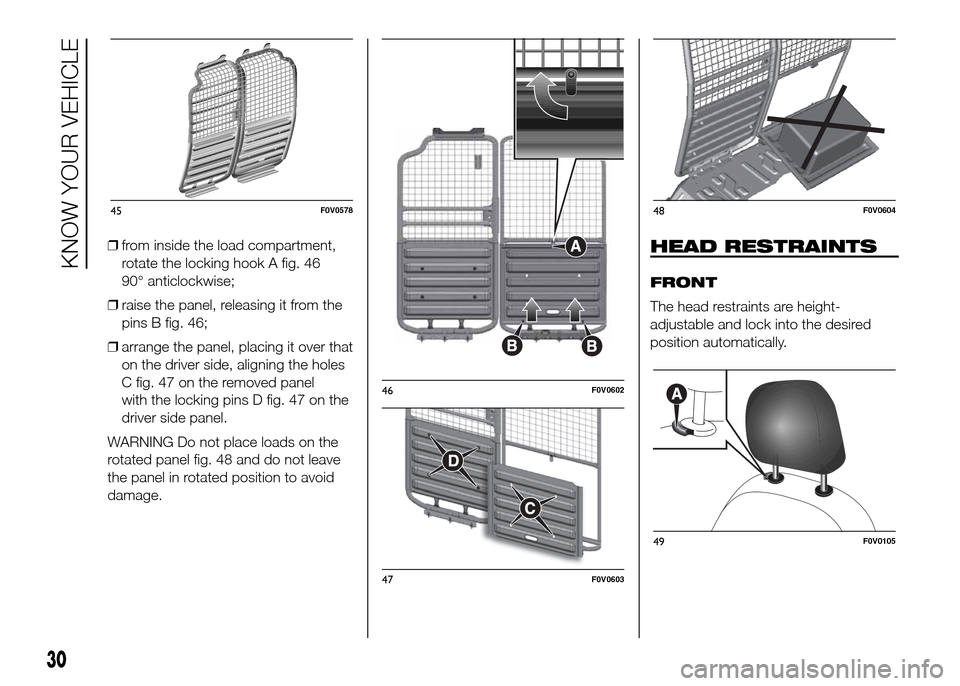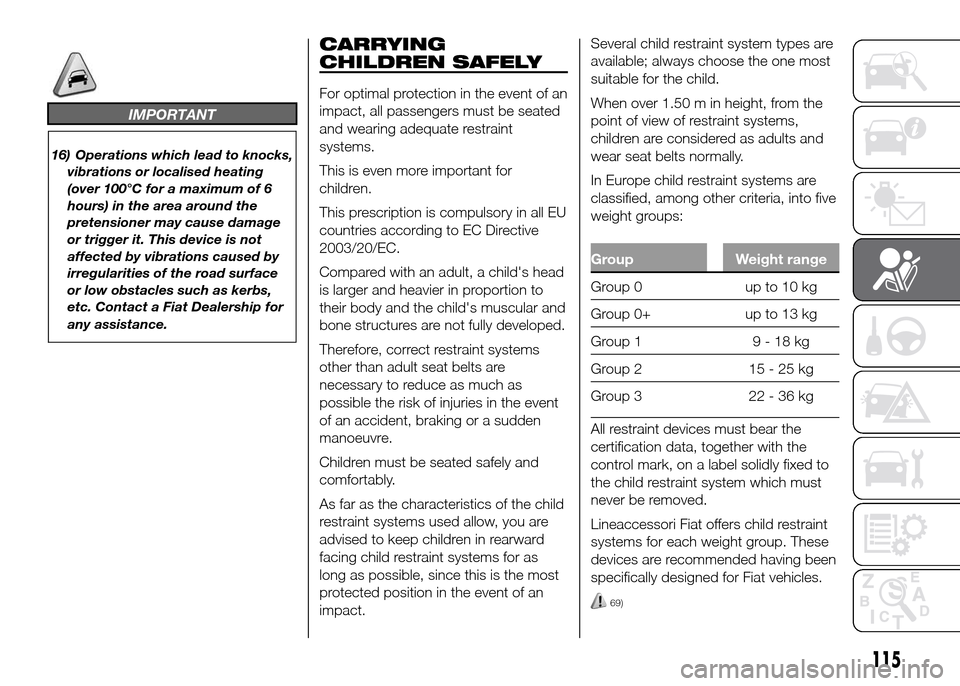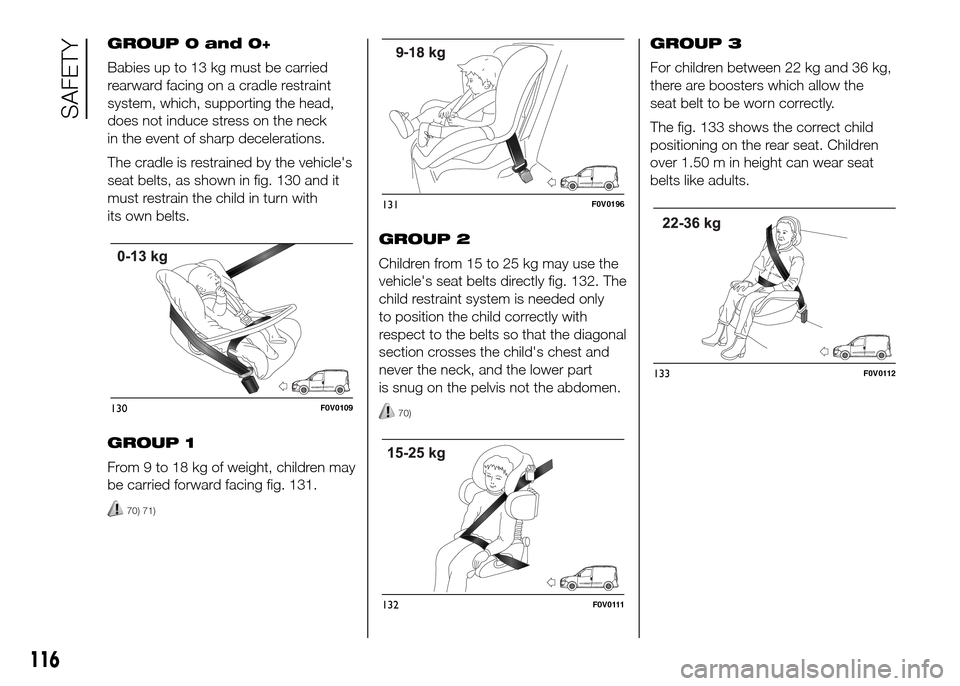2016 FIAT DOBLO PANORAMA height
[x] Cancel search: heightPage 28 of 323

DRIVER’S SEAT
(for Doblò/Doblò Combi/Cargo
versions, where provided)
15)
Lengthwise adjustment
Lift the lever A fig. 25 and push the seat
forwards or backwards: in the driving
position your arms should rest on
the rim of the steering wheel.
16)
Backrest angle
adjustment
Turn knob B fig. 25
Driver seat height
adjustment
(for versions/markets, where provided)
Operate lever C fig. 25 to lift or lower
the rear part of the cushion to achieve
the most comfortable driving position.
IMPORTANT Adjustment must be
carried out only when seated in the
relevant seat.
Driver seat lumbar
adjustment
(for versions/markets, where provided)
Turn knob D fig. 25 to adjust the
backrest support.
Heated seats
(for versions/markets, where provided)
With the key turned to MAR, press
button A fig. 26 to switch the function
on/off.
When the function is enabled, the LED
on the button turns on.FOLDAWAY PASSENGER
SEAT
(for versions/markets, where provided)
The passenger seat can be folded
away on some Cargo versions.
17)
Completely retract the seat for a total
folding down avoiding interference with
the dashboard.
Seat folding
To fold the seat, proceed as follows:
❒open the passenger side door;
❒pull levers A and fold the backrest
forwards in the direction indicated
by the arrow;
❒then push the backrest B fig.
28down: the seat is now completely
folded over on itself into the "table"
position;
25F0V0013
26F0V0208
24
KNOW YOUR VEHICLE
Page 34 of 323

❒from inside the load compartment,
rotate the locking hook A fig. 46
90° anticlockwise;
❒raise the panel, releasing it from the
pins B fig. 46;
❒arrange the panel, placing it over that
on the driver side, aligning the holes
C fig. 47 on the removed panel
with the locking pins D fig. 47 on the
driver side panel.
WARNING Do not place loads on the
rotated panel fig. 48 and do not leave
the panel in rotated position to avoid
damage.
.
HEAD RESTRAINTS
FRONT
The head restraints are height-
adjustable and lock into the desired
position automatically.
45F0V0578
46F0V0602
47F0V0603
48F0V0604
49F0V0105
30
KNOW YOUR VEHICLE
Page 36 of 323

STEERING WHEEL
The height and axial position of the
steering wheel can be adjusted on all
versions.
To carry out the adjustment, proceed as
follows:
❒release lever A fig. 52 by pushing it
forwards (position 1);
❒adjust the steering wheel;
❒lock lever A fig. 52 by pulling it
towards the steering wheel (position
2).
24) 25)
WARNING
24) All adjustments must only be
carried out with the vehicle
stationary and the engine off.
25) Under no circumstances should
aftermarket operations involving
steering system or steering
column modifications (e.g.:
installation of anti-theft device) be
carried out that could badly
affect performance and safety.
This also causes the warranty to
become null and void and results
in vehicle non-compliance with
type-approval requirements.
REAR VIEW
MIRRORS
INTERIOR MIRROR
(for versions/markets, where provided)
The mirror is fitted with a safety device
that causes its release in the event of
a violent impact with the passenger.
Lever A fig. 53 can be used to move
the mirror to two different positions:
normal or antiglare.
Some versions may feature an internal
child surveillance mirror B fig. 54.
52F0V0014
53F0V0125
32
KNOW YOUR VEHICLE
Page 116 of 323

63)
ADJUSTING THE SEAT
BELT HEIGHT
64) 65)
The seat belt height can be adjusted to
various positions using the regulator
on the central pillar.
Always adjust the height of the seat
belts to fit the person wearing it: this
precaution could greatly reduce the risk
of injury in the event of collision.
Correct adjustment is obtained when
the belt passes approximately half way
between the shoulder and the neck.
WARNING
61) Never press button C fig. 123
when travelling.
62) Remember that, in the event of a
violent collision, back-seat
passengers not wearing seat belts
represent a serious danger to
the front-seat passengers as well
as to themselves.63) Make sure that the backrest is
correctly secured on both sides
(red bands B not visible) to
prevent it from moving forward in
the event of sharp braking,
causing injuries to passengers.
64) The height of the seat belts must
be adjusted with the vehicle
stationary.
65) After the height adjustment,
always check that the regulator is
locked in one of the preset
positions. To do this, push
downwards to enable the locking
device to click if the grip has
not been released in one of the
possible positions.
SBR SYSTEM
This system consists of a device which,
through the
warning light coming
on the instrument panel and,
depending on vehicle conditions, an
acoustic signal, warns the driver and
front passenger if their seat belts have
not been fastened (for versions where
provided).
If the driver side and/or the passenger
side seat belts are not fastened (with
passenger seated), when 20 km/h
is exceeded or when travelling at
a speed between 10 and 20 km/h for
longer than 5 seconds, an acoustic
signal sequence will be started
(continuous acoustic signal for the first
6 seconds followed by about 90
seconds of intermittent beeping and the
warning light will flash).
At the end of the cycle the
warning
light will stay on fixed until the engine is
switched off or the seat belts are
fastened.
For permanent deactivation, contact a
Fiat Dealership.
The SBR system can also be
reactivated through the setup menu.
112
SAFETY
Page 119 of 323

IMPORTANT
16) Operations which lead to knocks,
vibrations or localised heating
(over 100°C for a maximum of 6
hours) in the area around the
pretensioner may cause damage
or trigger it. This device is not
affected by vibrations caused by
irregularities of the road surface
or low obstacles such as kerbs,
etc. Contact a Fiat Dealership for
any assistance.
CARRYING
CHILDREN SAFELY
For optimal protection in the event of an
impact, all passengers must be seated
and wearing adequate restraint
systems.
This is even more important for
children.
This prescription is compulsory in all EU
countries according to EC Directive
2003/20/EC.
Compared with an adult, a child's head
is larger and heavier in proportion to
their body and the child's muscular and
bone structures are not fully developed.
Therefore, correct restraint systems
other than adult seat belts are
necessary to reduce as much as
possible the risk of injuries in the event
of an accident, braking or a sudden
manoeuvre.
Children must be seated safely and
comfortably.
As far as the characteristics of the child
restraint systems used allow, you are
advised to keep children in rearward
facing child restraint systems for as
long as possible, since this is the most
protected position in the event of an
impact.Several child restraint system types are
available; always choose the one most
suitable for the child.
When over 1.50 m in height, from the
point of view of restraint systems,
children are considered as adults and
wear seat belts normally.
In Europe child restraint systems are
classified, among other criteria, into five
weight groups:
Group Weight range
Group0 upto10kg
Group 0+ up to 13 kg
Group 1 9 - 18 kg
Group 2 15 - 25 kg
Group 3 22 - 36 kg
All restraint devices must bear the
certification data, together with the
control mark, on a label solidly fixed to
the child restraint system which must
never be removed.
Lineaccessori Fiat offers child restraint
systems for each weight group. These
devices are recommended having been
specifically designed for Fiat vehicles.
69)
115
Page 120 of 323

GROUP 0 and 0+
Babies up to 13 kg must be carried
rearward facing on a cradle restraint
system, which, supporting the head,
does not induce stress on the neck
in the event of sharp decelerations.
The cradle is restrained by the vehicle's
seat belts, as shown in fig. 130 and it
must restrain the child in turn with
its own belts.
GROUP 1
From 9 to 18 kg of weight, children may
be carried forward facing fig. 131.
70) 71)
GROUP 2
Children from 15 to 25 kg may use the
vehicle's seat belts directly fig. 132. The
child restraint system is needed only
to position the child correctly with
respect to the belts so that the diagonal
section crosses the child's chest and
never the neck, and the lower part
is snug on the pelvis not the abdomen.
70)
GROUP 3
For children between 22 kg and 36 kg,
there are boosters which allow the
seat belt to be worn correctly.
The fig. 133 shows the correct child
positioning on the rear seat. Children
over 1.50 m in height can wear seat
belts like adults.
130F0V0109
131F0V0196
132F0V0111
133F0V0112
116
SAFETY
Page 228 of 323

WHEELS
RIMS AND TYRES
Pressed steel or alloy rims. Tubeless
radial carcass tyres. All approved tyres
are listed in the registration document.
IMPORTANT If there are any
discrepancies between the Owner
Handbook and the registration
document, take the information from
the latter.
For safe driving, the vehicle must be
fitted with tyres of the same make and
type on all wheels.
IMPORTANT Do not use air chambers
with tubeless tyres.
SPARE WHEEL
Pressed steel rim. Tubeless tyre.
WHEEL GEOMETRY
Front wheel toe-in measured from rim
to rim: -1±1mm.
The values refer to the vehicle in
running order.CORRECT READING OF
THE TYRE
Example: 185/65 R 15
88H(see fig. 229)
185Rated width (S, distance in mm
between sidewalls)
65Height/width ratio (H/S) as a
percentage
RRadial tyre
15Rim diameter in inches (Ø)
88Load index (payload)
HMaximum speed index
Maximum speed index
Qup to 160 km/h
Rup to 170 km/h
Sup to 180 km/h
Tup to 190 km/h
Uup to 200 km/h
Hup to 210 km/h
Vup to 240 km/h
Maximum speed index
for snow tyres
QM+Sup to 160 km/h
TM+Sup to 190 km/h
HM+Sup to 210 km/h
Load index (payload)
70335 kg
71345 kg
72355 kg
73365 kg
74375 kg
75387 kg
76400 kg
77412 kg
78425 kg
79437 kg
80450 kg
81462 kg
82475 kg
83487 kg
84500 kg
85515 kg
86530 kg
87545 kg
88560 kg
89580 kg
229F1A0247
224
TECHNICAL SPECIFICATIONS
Page 235 of 323

DIMENSIONS
Short wheelbase versions
Dimensions are expressed in mm and refer to the vehicle fitted with standard tyres.
The height refers to the unladen vehicle.
ABCDE FGH
4406 911 2755 740 1845/1895(*) 1510 1832 1530
(*) With roof bars (for versions/markets where provided)
Small variations in size are possible depending on the dimensions of the rims.
231F0V0555
231